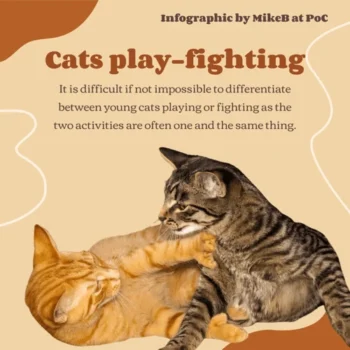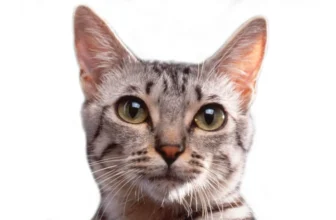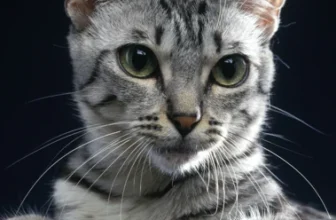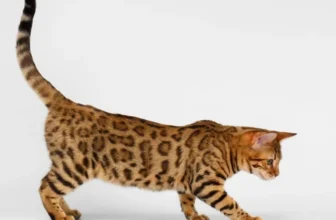As cat owners, we all dream of having a litter of adorable kittens to play with and watch grow. However, sometimes our California Spangled cats may face infertility issues, leaving us feeling perplexed and disappointed. Infertility in cats can be caused by a variety of factors, including medical conditions, genetic predispositions, and environmental factors. In this article, we will delve into the causes and signs of infertility in California Spangled cats, as well as options for diagnosis and treatment. We will also provide tips for caring for your cat during and after infertility treatment, so that you can give your furry friend the best possible care.
Understanding Infertility in California Spangled Cats
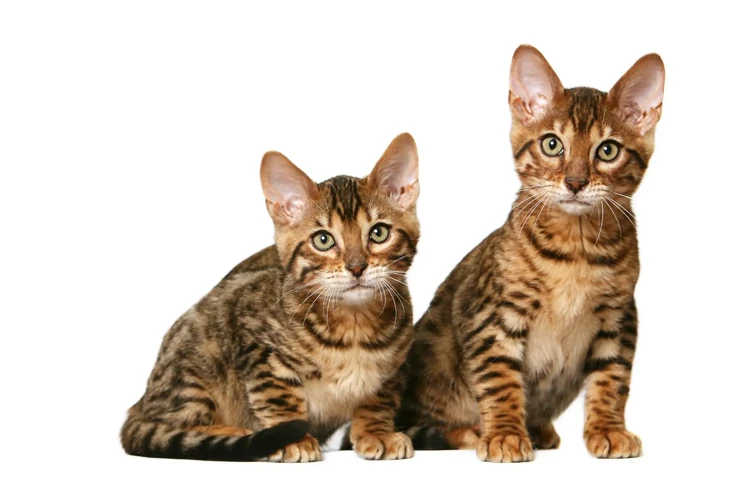
It can be heartbreaking when your beloved California Spangled cat isn’t able to conceive a litter of kittens. Infertility, or the inability to produce offspring, is a common issue that many cat owners face. If you’re dealing with this situation, it’s important to understand the causes, signs, and diagnosis options for infertility in California Spangled cats. This knowledge can help you to make informed decisions about treatment options and ways to prevent future infertility issues. In the following sections, we will dive into the details of understanding infertility in California Spangled cats, including possible causes and prevention tips. To read more about preparing California Spangled Cats for breeding and optimal breeding age, check out this article and this resource.
Causes of Infertility in California Spangled Cats
Infertility in California Spangled Cats can occur due to various reasons. Here are the most common causes of infertility:
- Genetic Disorders: Certain genetic defects can cause infertility in California Spangled Cats. For instance, some cats may inherit abnormalities in the reproductive organs or chromosomes which may reduce their chances of successful mating and pregnancy. Such genetic defects can be diagnosed by a veterinary genetics specialist.
- Reproductive disorders: California Spangled cats can develop reproductive disorders such as cysts, tumors, or infections in the reproductive organs that interfere with their fertility. These disorders can be caused by hormonal imbalances, poor nutrition, or infections. Female cats may also suffer from irregular heat cycles or failures to ovulate, which can make them less fertile.
- Mating problems: Successful mating in California Spangled cats can be affected by a variety of factors. These include aggression between the mating pair, mismatched timing of heat cycles, or inexperience and clumsiness of one or both partners. If you want to learn more about successful mating in California Spangled cats, check out our Cali Spangled Cat Mating Guide.
- Aging: As a California Spangled cat gets older, its fertility may decline as its reproductive system undergoes changes. Female cats may experience a reduction in the number of viable eggs produced, while male cats may experience reduced sperm count or quality.
- Other health problems: Infertility in California Spangled cats can also be caused by underlying illnesses such as diabetes, kidney disease, or cancer. These diseases can affect the hormones and metabolism needed for successful reproduction. If you observe signs of illness in your cat, seek immediate veterinary attention.
By identifying the cause of infertility in your California Spangled cat, your veterinarian can recommend the most appropriate treatment options. Some signs of successful mating in California Spangled cats are discussed in 5 Signs of Successful Mating in California Spangled Cats. If your cat is currently pregnant, be sure to read up on California Spangled Cat Birthing to ensure a smooth delivery.
Signs of Infertility in California Spangled Cats
Infertility in cats can be quite distressing to pet owners who are trying to breed their cats. California Spangled Cats are a popular breed of cat that are known for their intelligence and athleticism, but they are not immune to infertility. As a cat owner, it is important to know the signs of infertility in your feline friend so that you can seek veterinary help promptly.
| Signs of Infertility in California Spangled Cats |
|---|
| Irregular Heat Cycles: A healthy cat usually goes into heat cycles every 1-3 weeks. If your California Spangled Cat’s heat cycle is infrequent or absent, it might be a sign that your cat is infertile. |
| Abnormal Discharge: Vaginal discharge that is bloody or contains pus can be a sign of infertility, and could indicate underlying health issues. |
| Lack of Pregnancy: If your California Spangled Cat has been actively trying to breed for over a year but hasn’t conceived yet, it may be a sign of infertility. |
| Little to No Milk Production: After giving birth, cats should produce sufficient milk to feed their offspring. If your cat is struggling, it could be a sign of infertility. |
It’s important to remember that infertility can be caused by a variety of factors, including genetics. If your California Spangled Cat is displaying any of these signs, it is recommended to consult a veterinarian. The vet may conduct a thorough physical examination and run some tests to determine the underlying cause of your cat’s infertility. Some cats may require hormonal therapy or surgical treatment to address the issue. To learn more about the genetics of California Spangled Cats, check out our article on genetics in California Spangled Cats.
Diagnosing Infertility in California Spangled Cats
When it comes to diagnosing infertility in California Spangled cats, there are several steps that must be taken before a conclusive diagnosis can be reached. These steps include:
1. Physical Examination: A physical exam is usually the first step in diagnosing infertility in cats. During this exam, a veterinarian will carefully examine your cat’s reproductive organs to look for any physical abnormalities or signs of infection.
2. Blood Tests: Blood tests can also be used to diagnose infertility in cats. These tests can measure hormone levels in your cat’s bloodstream, which can help identify any hormonal imbalances that may be contributing to infertility.
3. Urine Tests: Urine tests may also be used to diagnose infertility in cats. These tests can help identify potential infections or other issues that may be impacting your cat’s reproductive health.
4. Imaging Tests: Imaging tests, such as ultrasounds or X-rays, may be used to take a closer look at your cat’s reproductive organs. These tests can help identify any physical abnormalities that may be contributing to infertility.
5. Semen Analysis: If you have a male cat that is experiencing infertility, a semen analysis may be necessary. This test can help identify any issues with your cat’s sperm count or motility.
6. Breeding History: Your veterinarian will likely ask about your cat’s breeding history to look for any potential issues or patterns that may be contributing to infertility.
Diagnosing infertility in California Spangled cats can be a complex process that requires careful examination and testing. If you suspect that your cat may be experiencing infertility, it’s important to work closely with your veterinarian to develop an appropriate diagnostic and treatment plan.
How to Prevent Infertility in California Spangled Cats
Preventing infertility in California Spangled Cats can be achieved by implementing specific measures that help maintain their reproductive health. Here are some steps that can be taken:
| Step | Description |
|---|---|
| Spaying/Neutering | Spaying or neutering your California Spangled Cat at a young age can help prevent unwanted pregnancies and reproductive health problems later in life. |
| Diet and Exercise | A balanced diet and regular exercise can help maintain your cat’s overall health, including their reproductive system. Overweight or obese cats are at higher risk of developing reproductive health issues. |
| Regular Vet Checkups | Regular veterinary checkups can help detect any potential reproductive health problems early on. This can lead to faster treatment and better outcomes. |
| Minimize Environmental Stressors | Exposure to environmental stressors such as loud noises or extreme temperatures can have negative effects on your cat’s reproductive health. Minimizing exposure to these stressors can help promote reproductive health. |
| Avoid Overbreeding | Overbreeding can lead to an increased risk of reproductive health problems in California Spangled Cats. It’s important to limit breeding to promote your cat’s reproductive health and overall wellbeing. |
Implementing these preventative measures can help ensure the reproductive health and wellbeing of your California Spangled Cat for years to come. It’s important to discuss any concerns or questions with your veterinarian to develop a customized preventative plan for your cat.
Treatment Options for Infertility in California Spangled Cats
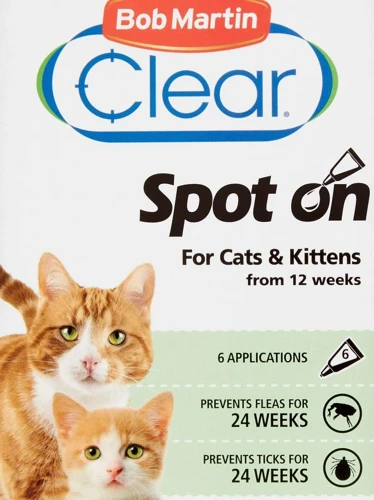
One of the most devastating things for a cat owner is the realization that their furry friend may be infertile. Fortunately, there are various treatment options available for California Spangled Cats suffering from infertility. These treatment options can help increase your cat’s chances of becoming pregnant and having a healthy litter. Let’s explore some of the treatment options that you may consider for your beloved cat.
Medication and Hormonal Therapy
One treatment option for infertility in California Spangled Cats is medication and hormonal therapy. This type of treatment is often used when there are hormonal imbalances or ovulation issues causing the infertility. The medication is designed to help regulate the cat’s hormones and stimulate ovulation.
There are several options for medication and hormonal therapy for California Spangled Cats, including:
| Medication | Usage | Possible Side Effects |
|---|---|---|
| Clomiphene | To stimulate follicle growth and ovulation | Nausea, vomiting, hot flashes, and mood changes |
| Progesterone supplements | To boost progesterone levels and support pregnancy | Increased thirst, urination, and hunger |
| Gonadotropins (FSH and LH) | To stimulate ovarian follicles and trigger ovulation | Ovarian hyperstimulation syndrome (OHSS), multiple pregnancies, and miscarriage |
It is important to note that these medications should only be used under the guidance of a veterinarian, as they can have serious side effects if not prescribed and administered properly. Monitoring the cat’s response to the medication is also critical, as overstimulation can occur and lead to adverse outcomes.
Hormonal therapy may also be used to treat infertility in California Spangled Cats. This may involve the use of synthetic hormones, such as estrogen or progesterone, to regulate the cat’s reproductive system. It is important to note that hormonal therapy should be used with caution, as it can have long-term effects on the cat’s health.
Medication and hormonal therapy can be effective in treating infertility in California Spangled Cats, but it must be used carefully and under the guidance of a veterinarian. Regular monitoring and follow-up care are critical to ensure the cat’s health and well-being.
Surgical Intervention
When medication and hormonal therapy do not work in treating infertility in your California Spangled cat, surgical intervention may be necessary. Surgery is usually done under general anesthesia, and the type of surgery will depend on the underlying cause of infertility.
Ovariohysterectomy: A common surgical intervention for female California Spangled cats is ovariohysterectomy, also known as spaying. This involves removing the ovaries and uterus, effectively eliminating the possibility of pregnancy. Spaying not only prevents unwanted litters but also reduces the risk of certain reproductive system diseases such as uterine infections, ovarian cysts, and breast tumors.
Orchidectomy: For male California Spangled cats, orchidectomy, also known as neutering, is the most common surgical procedure. It involves removing the testes, which helps reduce the risk of certain reproductive system cancers and decreases aggressiveness in male cats, making them more docile.
Tubal Ligation: In some cases, tubal ligation may be recommended for female California Spangled cats with fertility problems. This involves tying the fallopian tubes, which prevents the eggs from reaching the uterus but allows for the passage of eggs into the abdomen for reabsorption. This procedure can help maintain hormonal balance in the cat’s body and reduces the risk of certain reproductive system diseases.
Vasectomy: For male California Spangled cats, vasectomy may be a viable option for those breeding cats because it only involves cutting and sealing the vas deferens, which prevents the sperm from passing through. This surgery does not affect the sexual behavior of the cat and can also maintain hormonal balance.
It is important to consult with a veterinarian who specializes in reproductive medicine before opting for surgical intervention for infertility. The vet will assess your cat’s overall health, underlying condition causing infertility, and recommend the most appropriate surgical procedure for your cat. Post-operative care is crucial to ensure your cat recovers well, and your vet will advise you on proper aftercare for your cat.
Alternative Approaches
There are several alternative approaches to consider when dealing with infertility in California Spangled cats. These methods may not be scientifically proven, but some cat owners have found them helpful. Here are some alternative approaches to consider:
- Acupuncture: This traditional Chinese medicine technique involves the application of needles to specific points on the body. Some people believe that acupuncture can help stimulate fertility in cats by improving blood flow to the reproductive organs.
- Moxibustion: This is a form of heat therapy that involves burning dried mugwort leaves near the skin. Some people believe that moxibustion can help increase fertility by improving circulation and raising the internal temperature of the body.
- Herbal remedies: There are several herbs that are believed to be beneficial for fertility in cats. For instance, red clover is thought to help balance hormones, while raspberry leaf is believed to strengthen the uterus and improve reproductive function.
- Dietary changes: Some cat owners have found that switching their cat’s diet to a raw food diet or a diet high in meat protein can help improve fertility.
- Stress reduction: Stress can have negative effects on fertility in both humans and animals. Reducing stress levels through techniques such as yoga or meditation may improve your cat’s chances of conceiving.
It’s important to note that these alternative approaches are not a substitute for medical treatment. If you suspect that your California Spangled cat is infertile, it’s important to consult with a veterinarian to determine the underlying cause and appropriate treatment. However, if you are interested in exploring these alternative approaches, it’s best to do so under the guidance of a trained practitioner.
Caring for Your California Spangled Cat After Infertility Treatment
After undergoing infertility treatment, your California Spangled cat will need time to rest and recover. You’ll need to provide special care and attention to ensure that your cat’s body is able to fully heal and regain its strength. Additionally, you’ll need to take certain precautions to help prevent future infertility issues from occurring. In this section, we’ll discuss some tips and strategies for caring for your California Spangled cat after infertility treatment. From recovery and follow-up care to nutrition and exercise recommendations, we’ll cover everything you need to know to help your cat get back to feeling its best.
Let’s dive in and explore the best ways to care for your California Spangled cat post-infertility treatment.
Recovery and Follow-Up Care
After undergoing infertility treatment, it’s important to prioritize your California Spangled cat’s recovery and follow-up care. This includes monitoring your cat’s progress and ensuring they are healing properly after any surgical procedures or medication therapy. Here are some important steps to keep in mind:
| Step | Description |
|---|---|
| 1 | Visit your veterinarian for follow-up appointments to monitor your cat’s progress and ensure they are healing properly after any surgical procedures or medication therapy. |
| 2 | Observe your cat’s behavior carefully to detect any signs of complications or side effects from the treatment. If your cat is experiencing any unusual symptoms, contact your veterinarian immediately. |
| 3 | Provide your cat with a comfortable and quiet space to rest and recuperate. Make sure they are not able to jump or run around too much during their recovery period. |
| 4 | Monitor your cat’s diet and ensure they are eating a balanced, nutritious diet to support their recovery. Your veterinarian may recommend a specific diet plan for your cat during their recovery period. |
| 5 | Administer any prescribed medication or follow any prescribed treatment plan as directed by your veterinarian. This may include giving your cat medication at specific times of the day or following a specific exercise plan to support their recovery. |
By following these steps and providing proper follow-up care, you can help ensure your California Spangled cat makes a full and speedy recovery after infertility treatment. Remember to always consult with your veterinarian with any questions or concerns you may have about your cat’s recovery and care.
Nutrition and Exercise Recommendations
After infertility treatment, it is essential to maintain a healthy diet and exercise routine to ensure the best possible outcome for your California Spangled Cat. Here are some nutrition and exercise recommendations to follow:
Nutrition Recommendations:
1. Provide your cat with a high-quality, balanced diet that contains all the necessary nutrients and minerals.
2. Feed your California Spangled Cat small, frequent meals throughout the day, as opposed to one or two large meals. This will help prevent overeating and promote digestion.
3. Avoid feeding your cat table scraps or human food, as they can cause digestive issues and lead to obesity.
4. Always ensure your cat has access to clean water at all times.
5. Consider adding supplements, such as omega-3 fatty acids or probiotics, to your cat’s diet. Consult with your veterinarian before doing so.
Exercise Recommendations:
1. Encourage your California Spangled Cat to exercise daily by providing opportunities for play and physical activity.
2. Provide your cat with toys that encourage activity, such as cat trees, scratching posts, and interactive toys.
3. Engage in interactive play with your cat, such as chasing a toy or playing with a laser pointer.
4. Allow your cat to explore their environment, both indoors and outdoors, in a safe and supervised manner.
5. Consult with your veterinarian regarding appropriate levels of exercise for your cat, especially if they have any underlying health conditions.
By following these nutrition and exercise recommendations after infertility treatment, you can help promote your California Spangled Cat’s overall health and well-being. Remember to always consult with your veterinarian regarding any changes to your cat’s nutrition or exercise routine.
Maintaining a Healthy Home Environment
Maintaining a healthy home environment is crucial to ensuring the well-being of your California Spangled cat, especially after infertility treatment. Below are some tips for creating a clean and safe space for your feline friend.
| Tips for maintaining a healthy home environment: | |
|---|---|
| Regular cleaning: | Make sure to clean up any messes as soon as possible to prevent odors and bacteria buildup. Use pet-friendly cleaning products to avoid harmful chemicals that may affect your cat’s health. |
| Litter box care: | Scooping your cat’s litter box daily and completely changing the litter every 1-2 weeks is essential in preventing infections and diseases. Choose a litter box that is appropriate for your cat’s size and make sure it is in a quiet and private area. |
| Avoid toxic substances: | Certain household items such as plants, cleaners, and some human foods can be poisonous to cats. Keep them out of reach or better yet, avoid them altogether. |
| Provide plenty of water: | Make sure your cat has easy access to plenty of fresh, clean water at all times. This will help prevent dehydration and encourage overall good health. |
| Balanced diet: | Consult with your vet to ensure your cat is on a balanced diet that meets their specific nutritional needs. Avoid overfeeding and stick to a regular feeding schedule. |
| Playtime and exercise: | Provide toys, scratching posts, and plenty of space for your cat to play and exercise. This not only keeps them physically fit, but also promotes mental well-being. |
By following these tips and providing a healthy environment for your California Spangled cat, you can help ensure their continued health and happiness. Remember to consult with your vet for any specific concerns or questions about your cat’s care.
Conclusion
After understanding and dealing with infertility in your California Spangled cat, it’s important to take preventative measures to avoid future issues. Regular vet checkups and monitoring your cat’s reproductive health are crucial. Additionally, maintaining a healthy and stress-free home environment can also help prevent problems with fertility.
If your California Spangled cat is experiencing infertility, there are a variety of treatment options available, including medication, hormonal therapy, surgery, and alternative approaches such as acupuncture and herbs. It’s best to consult with your veterinarian to determine the most appropriate course of action.
After treatment, it’s important to provide your cat with the necessary care and attention for a successful recovery. This may include a specialized diet and exercise plan, as well as maintaining a clean and comfortable living environment.
While infertility in cats can be a complicated and stressful issue, it’s important to remain optimistic and take proactive measures to ensure your pet’s health and well-being. With the right care and attention, most California Spangled cats can lead happy and healthy lives, free from the burden of infertility.
Frequently Asked Questions
Can all California Spangled Cats experience infertility?
No, not all California Spangled Cats will experience infertility, but it can occur in both males and females.
What are common causes of infertility in California Spangled Cats?
Common causes can include underlying medical conditions, genetic abnormalities, age, or environmental factors.
Can spaying or neutering a California Spangled Cat lead to infertility?
Yes, spaying or neutering a California Spangled Cat can lead to infertility since the reproductive organs are removed during the procedure.
What are the signs that my California Spangled Cat is infertile?
Signs can include irregular heat cycles, lack of mating behavior, abnormal discharge, or difficulty conceiving.
Can my California Spangled Cat still have a happy life if they are infertile?
Absolutely, infertility does not typically impact the overall quality of life for a California Spangled Cat and they can still live a happy and healthy life.
Is infertility in California Spangled Cats a common issue?
Infertility is not a common issue, but it can occur just like any other health condition.
What steps can I take to prevent infertility in my California Spangled Cat?
Keeping your cat healthy, providing adequate nutrition and exercise, and regular veterinary checkups can help prevent infertility in California Spangled Cats.
What are medication and hormonal therapy options for treating infertility in California Spangled Cats?
Medications and hormonal therapy can include oral medications or injections to regulate hormones and increase fertility.
Is surgery a common form of treatment for infertility in California Spangled Cats?
Surgery may be recommended in certain cases of infertility in California Spangled Cats, but it is not a common form of treatment.
What should I expect during the recovery period after infertility treatment for my California Spangled Cat?
The recovery period will depend on the specific treatment utilized, but it is important to follow all post-operative care instructions provided by your veterinarian.

